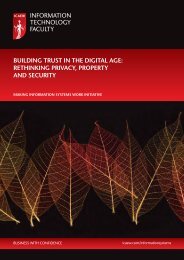Security Effectiveness Framework Study
Security Effectiveness Framework Study
Security Effectiveness Framework Study
You also want an ePaper? Increase the reach of your titles
YUMPU automatically turns print PDFs into web optimized ePapers that Google loves.
<strong>Security</strong> <strong>Effectiveness</strong> <strong>Framework</strong> study<br />
Appendix 1:<br />
<strong>Security</strong> <strong>Effectiveness</strong> Survey<br />
Dear respondent,<br />
We want to learn about your organisation’s present capability to achieve an<br />
operationally effective security environment.<br />
We appreciate your thorough responses to all benchmark survey questions.<br />
Please be assured that we will not collect any personally identifiable information.<br />
Your identity will remain completely confidential. Please contact Ponemon Institute<br />
at research@ponemon.org or call us at 1.800.887.3118 if you have any questions<br />
about this research.<br />
Thank you in advance for your participation.<br />
Dr. Larry Ponemon<br />
Chairman & founder<br />
Definitions:<br />
<strong>Security</strong> posture: describes your organisation’s ability<br />
to prevent, detect and resolve internal and external threats<br />
against assets, information resources and IT infrastructure.<br />
<strong>Security</strong> environment: the company’s overall approach<br />
to creating an effective security ecosystem.<br />
Enabling technologies: describes specific security<br />
solutions, systems and tools used to mitigate or curtail<br />
security threats, vulnerabilities and risks.<br />
Control activities: describes specific control procedures<br />
deployed to mitigate or curtail security threats, vulnerabilities<br />
and risks.<br />
Governance: describes the company’s oversight<br />
structure that establishes accountability over security and<br />
data protection activities.<br />
Uptime: the company’s ability to withstand attacks that<br />
cause systemic failure and business interruption.<br />
Threat containment: the company’s ability to prevent<br />
or quickly detect external security threats such as cyber<br />
crime, social engineering or malicious outsiders.<br />
Cost efficiency: the ability to manage investments in<br />
information security and data protection in a competent<br />
(non-wasteful) manner.<br />
Breach prevention: the ability to prevent or quickly<br />
detect internal security threats such as the negligent or<br />
incompetent insider.<br />
Policy enforcement: the ability to monitor and strictly<br />
enforce compliance with internal policies, procedures and<br />
other security requirements.<br />
22<br />
Sponsored by: HP Information <strong>Security</strong> and Check Point Software Technologies Ltd.<br />
Ponemon Institute © Research Report & Instrument



